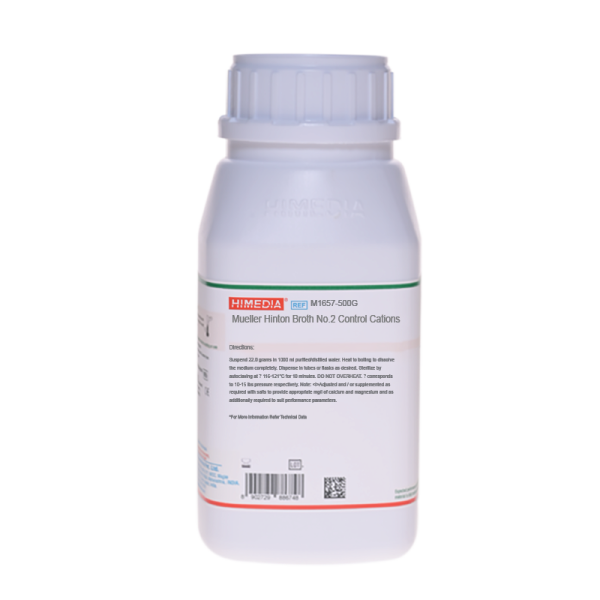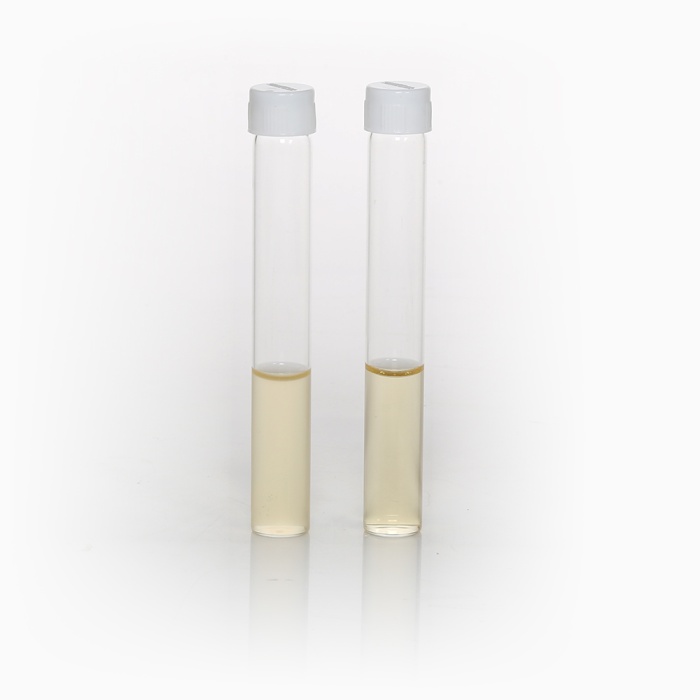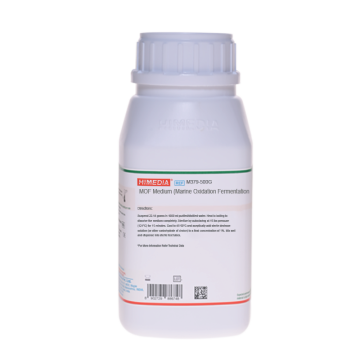 Your enquiry has been submitted
Your enquiry has been submitted
Mueller Hinton Broth No. 2 Control Cations
Intended Use
Used in quantitative procedures for susceptibility testing of rapidly growing aerobic and facultatively anaerobic bacteria isolated from clinical specimens.
Composition**
| Ingredients | g / L |
|---|---|
| HM peptone B # | 3.000 |
| Acicase™ $ | 17.500 |
| Starch | 1.500 |
Final pH (at 25°C): 7.3±0.1
**Formula adjusted, standardized to suit performance parameters # Equivalent to Beef extract $ Equivalent to Casein acid hydrolysate
Directions
Suspend 22.0 grams in 1000 ml purified/distilled water. Heat to boiling to dissolve the medium completely. Dispense in tubes or flasks as desired. Sterilize by autoclaving at ∆ 116-121°C for 10 minutes. DO NOT OVERHEAT.
∆ corresponds to 10-15 lbs pressure respectively. Note: Adjusted and / or supplemented as required with salts to provide appropriate mg/l of calcium and magnesium and as additionally required to suit performance parameters.
Principle And Interpretation
The Mueller Hinton formulation was originally developed as a simple, transparent agar medium for the cultivation of pathogenic Neisseria (1). Development of other media led to the replacement of the use of Mueller Hinton Agar for the cultivation of pathogenic Neisseria, but it became widely used in the determination of sulfonamide resistance of gonococci and other organisms. It is now used as a test medium for antimicrobial susceptibility testing (2).
Mueller Hinton Broth No. 2 Control Cations is used in the susceptibility testing of rapidly growing aerobic and facultatively anaerobic bacteria from clinical specimens. The medium is designed to give a low thymine and thymidine content and also the calcium and magnesium ion concentration is adjusted as recommended by CLSI (2). The medium is not recommended for fastidious organisms. Thymine and thymidine inhibit sulfonamide and trimethoprim (3,4) activity and calcium and magnesium (5,6) interferes with the activity of aminoglycoside antibiotics.
HM peptone B and Acicase™ provide nitrogenous compounds, carbon, sulphur and other essential nutrients. Starch acts as a protective colloid against toxic substances present in the medium. Starch hydrolysis yields dextrose, which serves as a source of energy. These ingredients are selected for low thymine and thymidine content as determined by MIC values for Enterococcus faecalis with sulfamethoxazole trimethoprim (SXT).
Type of specimen
Clinical samples : Pure cultures isolated from urine, stool etc.
Specimen Collection and Handling
In Mueller Hinton Broth No. 2 Control Cations, antimicrobial agents are prepared in serial two-fold dilutions and are inoculated with the test culture to give a final concentration of 5×105 CFU/ml. Following incubation at 35°C; the presence of turbidity indicates growth of the organism. The lowest concentration of antimicrobial agent showing no growth is the MIC of that organism for that agent. The interpretation as to whether the organism is susceptible, intermediate, or resistant in its response to the agent is made by comparing the MIC to those in the MIC interpretive standards in CLSI standard M7 (9,10). Various factors have been identified as influencing broth dilution susceptibility tests. These include the medium, antimicrobial potency, inoculum concentration, pH, antimicrobial stability and mechanisms of resistance by the test organisms (2,8,12). After use, contaminated materials must be sterilized by autoclaving before discarding.
Warning and Precautions
In Vitro diagnostic use only. For professional use only. Read the label before opening the container. Wear protective gloves/protective clothing/eye protection/face protection. Follow good microbiological lab practices while handling specimens and culture. Standard precautions as per established guidelines should be followed while handling clinical specimens. Safety guidelines may be referred in individual safety data sheets.
Limitations
- This medium is recommended for susceptibility testing of pure cultures only.
- Inoculum density may affect the zone size. Heavy inoculum may result in smaller zones or too less inoculum may result in bigger zones.
- Fastidious organisms may not grow on this medium and may require supplementation of blood.
- Fastidious anaerobes may not grow on this medium.
- As antimicrobial susceptibility is carried with antibiotic disc, proper storage of the disc is desired which may affect the potency of the disc.
- Under certain circumstances, the in vitro results of antibiotic susceptibility may not show the same in vivo.
Performance and Evaluation
Performance of the medium is expected when used as per the direction on the label within the expiry period when stored at recommended temperature.
Quality Control
Appearance: Cream to yellow homogeneous free flowing powder
Colour and Clarity of prepared medium: Light amber coloured clear solution in tubes
Reaction: Reaction of 2.2% w/v aqueous solution at 25°C. pH : 7.3±0.1
pH: 7.20-7.40
Cation levels: Calcium: 20-25 mg/l Magnesium: 10-12.5 mg/l
Cultural Response
Cultural characteristics observed after an incubation at 35 - 37°C for 18 - 24 hours.
| Organism | Inoculum (CFU) | Growth |
|---|---|---|
| Escherichia coli ATCC 25922 (00013*) | 50-100 | good-luxuriant |
| Pseudomonas aeruginosa ATCC 27853 (00025*) | 50-100 | good-luxuriant |
| Staphylococcus aureus subsp. aureus ATCC 25923 (00034*) | 50-100 | good-luxuriant |
| Enterococcus faecalis ATCC 29212 (00087*) | 50-100 | good-luxuriant |
Key : *Corresponding WDCM numbers.
Storage and Shelf Life
Store between 10-30°C in a tightly closed container and the prepared medium at 15-30°C. Use before expiry date on the label. On opening, product should be properly stored dry, after tightly capping the bottle in order to prevent lump formation due to the hygroscopic nature of the product. Improper storage of the product may lead to lump formation. Store in dry ventilated area protected from extremes of temperature and sources of ignition Seal the container tightly after use. Product performance is best if used within stated expiry period.
Disposal
User must ensure safe disposal by autoclaving and/or incineration of used or unusable preparations of this product. Follow established laboratory procedures in disposing of infectious materials and material that comes into contact with clinical sample must be decontaminated and disposed of in accordance with current laboratory techniques (4,5).
Reference
- DAmato R. F., and Thornsberry C., 1979, Curr. Microbiol., 2 : 135
- Ericsson H. M. and Sherris J. L., 1971, Acta Pathol. Microbiol., Scand. Sect B Suppl., 217:1.
- Ferone R. Bushby R. M., Burchall J. J., Moore W. D., Smith D., 1975, Antimicrob. Agents chemotherap., 7 : 91
- Isenberg, H.D. Clinical Microbiology Procedures Handbook 2nd Edition.
- Jorgensen, J.H., Pfaller, M.A., Carroll, K.C., Funke, G., Landry, M.L., Richter, S.S and Warnock., D.W. (2015) Manual of Clinical Microbiology, 11th Edition. Vol. 1.
- Koch A. E. and Burchall J. J., 1971, Appl. Microbiol., 22: 812
- Mueller and Hinton. 1941. Proc. Soc. Exp. Biol. Med. 48:330.
- Murray P. R., Baron J. H., Pfaller M. A., Jorgensen J. H. and Yolken R. H., (Ed.), 2003, Manual of Clinical Microbiology, 8th Ed., American Society for Microbiology, Washington, D.C.
- National Committee for Clinical Laboratory Standards. 2000. Approved Standard: M7-A5. Methods for dilution antimicrobial susceptibility tests for bacteria that grow aerobically, 5th ed. NCCLS, Wayne, Pa.
- National Committee for Clinical Laboratory Standards, 2002, Performance Standards for antimicrobial susceptibility testing; 12th Informational Supplement, M100-S12(M7). NCCLS, Wayne, Pa.
- Pollock H. M., Minshew B. H., Kenney M. A., Schoenknecht F. D., 1978, Antimicrob. Agents Chemotherap.; 14:360
- Thornsberry C., Gavan T. L. and Gerlach E. H., 1977, Cumitech 6, New developments in antimicrobial agent susceptibility testing. Coord. Ed., Sherris. American Society for Microbiology, Washington, D.C.
| Product Name | Mueller Hinton Broth No. 2 Control Cations |
|---|---|
| SKU | M1657 |
| Product Type | Regular |
| Physical Form | Powder |
| Origin | Animal |
| Packaging type | HDPE |
| References | 1. Mueller and Hinton. 1941. Proc. Soc. Exp. Biol. Med. 48:330. |
| Customized Product Available | No |









